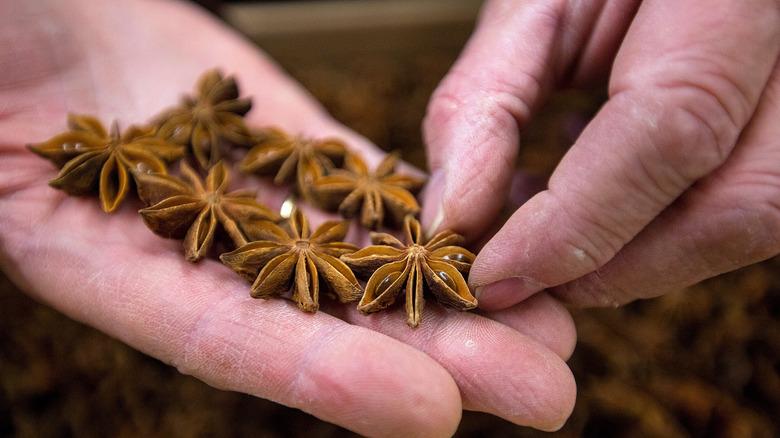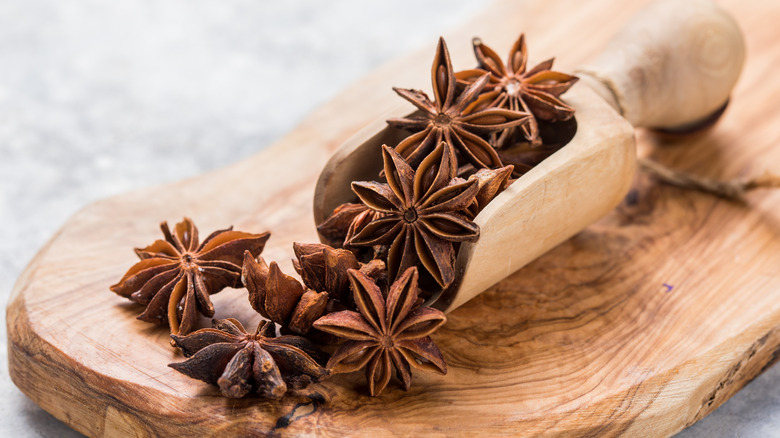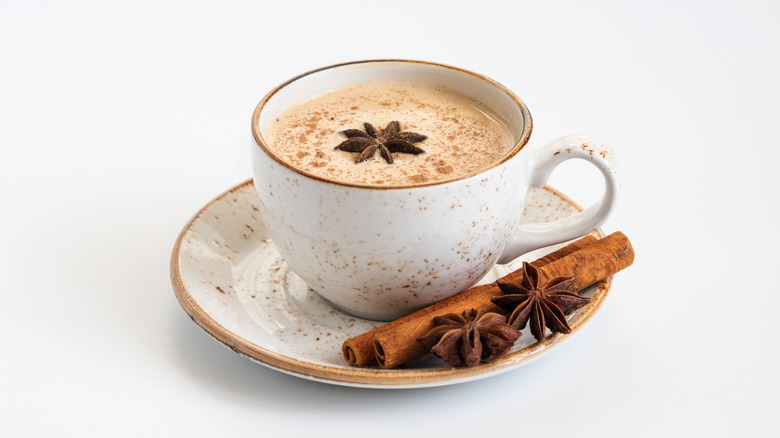What Is Star Anise And How Do You Cook With It?
Not to be mistaken for aniseed, star anise comes from a completely different plant family. If you've never used these ingredients, mixing them up would be easy to do because they are both small and share a similar licorice-like flavor. But unlike anise (Pimpinella anisum), Britannica says that star anise come from the star anise tree (Illicium verum), and its oils are commonly used to provide flavor and aroma to candies, liqueurs (like ouzo), and even perfumes. Star anise is a delicious spice with warm, sweet notes that is much stronger in aroma and flavor than aniseed, and, as you can tell, is a versatile little spice (via Fine Dining Lovers).
According to Cooking Chew, star anise, aka the Chinese star anise, are pods that grow in the shape of a 6-8 point star that, once picked, are dried out until they turn a red-brown color. Like cinnamon, the dried spice can be incorporated whole or ground and can be found mixed into Chinese five-spice powder or a variety of dishes that benefit from its spicy-sweet kick!
History of star anise
Like many popular spices, star anise is native to the Eastern hemisphere. Spiceography states that star anise was first discovered and developed in southeast China and, thus, is an extremely popular spice in traditional Chinese cuisine. The spice was not only considered delicious, but if you were lucky enough to find an eight-point star, the ancient Chinese thought it imparted good fortune.
Food History says that star anise also played an important role in Japanese culture. Star anise was traditionally used in Japanese medicine for over 3,000 years to soothe the liver and kidneys and relieve pain. Those who practiced traditional Japanese medicine would burn incense filled with star anise and mix it into their sweet and savory snacks and spirits, much like we still do. According to the University of Iowa, the star anise tree now grows across southern China, as well as the countries of Laos, Cambodia, India, the Philippines, and even Jamaica.
The health benefits of star anise
Star anise's medicinal properties have been lauded in the East for centuries, and for good reason. Healthline reports that star anise is useful in traditional and modern medicine, mainly due to the plant's production of shikimic acid. Shikimic acid is a chemical with strong antiviral, antifungal, and antibacterial properties, that have proven useful in flu medications and even cold sore treatments.
In addition to this, Organic Facts states that the star anise is rich in antioxidants, iron, vitamins, calcium, potassium, magnesium, fats, and dietary fiber, and contains a negligible amount of calories. This means that the star anise is helpful in lowering the risk of ailments like cancer, fungal infections, and viruses, and boosts the body's immune system, making it well worth adding to your diet. So you can easily give yourself a cheap immunity boost by brewing a home-remedy tea with this "star" ingredient.
How to use star anise
If you are curious how you can incorporate star anise spice into your kitchen, there is no shortage of options. Food Network says that it's delicious when added whole into broths, like you would a bay leaf, and Gordon Ramsay does the same for pots of rice. The dark, sweet, peppery flavor from the spice will bring depth to the flavor of your soups, whether they be a rich chicken pho recipe or a recuperative bone broth to help get you back on your feet.
Bon Appétit claims that it is better to buy the spice whole for steeping in your teas and soups, but also because you'll get a better flavor grinding the spice yourself with a mortar and pestle or spice grinder.
Once you have some freshly ground star anise, you can use it in almost any of your favorite traditional Chinese, Vietnamese, or Indian recipes, including pho, biryani, chai, and garam masala (via Taste of Home). But star anise doesn't stop being useful outside of Eastern cuisine. You can use it to flavor Western desserts like cookies, cakes, and beverages, as well as savory meals in marinades and stews.



